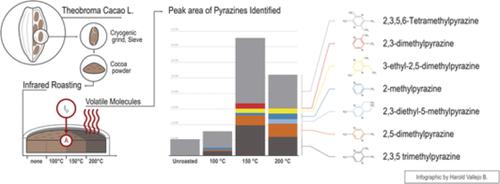当前位置:
X-MOL 学术
›
J. Food Process Eng.
›
论文详情
Our official English website, www.x-mol.net, welcomes your feedback! (Note: you will need to create a separate account there.)
Roasting impact on the chemical and physical structure of Criollo cocoa variety ( Theobroma cacao L )
Journal of Food Process Engineering ( IF 3 ) Pub Date : 2020-03-11 , DOI: 10.1111/jfpe.13400 Myriam Rojas S 1 , Farid Chejne 1 , Héctor Ciro 2 , Jorge Montoya 1
Journal of Food Process Engineering ( IF 3 ) Pub Date : 2020-03-11 , DOI: 10.1111/jfpe.13400 Myriam Rojas S 1 , Farid Chejne 1 , Héctor Ciro 2 , Jorge Montoya 1
Affiliation

|
This work analyzed the effect of infrared roasting at 100, 150, and 200°C on the main physical and chemical changes of cocoa. Raw and roasted cocoa were analyzed using Brunauer–Emmett–Teller, Fourier transform infrared spectroscopy, modulated differential scanning calorimetry (MDSC), thermogravimetric analysis (TGA), SPME, and GC‐MS. Using MDSC, the fusion of fat at around 35°C, and the desolvation of water and volatile compounds were identified. TGA detected loss of mass of various groups of chemical compounds, including those present pre‐roasting and generated during roasting. The unroasted cocoa's total sugar content of 2.71% decreased to 0.64% when roasted at 200°C, whereas roasting at 200°C generated seven (7) pyrazines. Tetramethylpyrazine is the most abundant, reaching the highest concentration when roasted at 150°C, but decreases when roasted at 200°C, due to the high temperature. To obtain the maximum production of favorable pyrazines, the temperature must be controlled based on the quality objectives of the final product. PRACTICAL APPLICATIONS: The process of roasting cocoa is of great importance to the chocolate and derivatives industry. Knowledge of the chemical and physical changes that occur during roasting can help to optimize the operating conditions to obtain a better‐quality product, in particular by conserving and developing the flavor and aroma of fine Criollo cocoa varieties. This will support the industrialization of fine cocoas, presenting an option for improving the economic and social development of marginalized countries and communities.
中文翻译:

焙烤对克里奥可可(Theobroma cacao L)化学和物理结构的影响
这项工作分析了在 100、150 和 200°C 下红外焙烧对可可主要物理和化学变化的影响。使用 Brunauer-Emmett-Teller、傅里叶变换红外光谱、调制差示扫描量热法 (MDSC)、热重分析 (TGA)、SPME 和 GC-MS 分析生可可和烤可可。使用 MDSC,确定了脂肪在 35°C 左右的融合以及水和挥发性化合物的去溶剂化。TGA 检测到各种化合物的质量损失,包括那些存在于烘焙前和烘焙过程中产生的化合物。在 200°C 下烘焙时,未烘焙可可的总糖含量从 2.71% 降至 0.64%,而在 200°C 下烘焙会产生七 (7) 种吡嗪。四甲基吡嗪含量最高,在 150°C 烘烤时浓度最高,但由于高温,在 200°C 烘烤时会减少。为了最大限度地生产有利的吡嗪,必须根据最终产品的质量目标控制温度。实际应用:烘焙可可的过程对巧克力和衍生品行业非常重要。了解烘焙过程中发生的化学和物理变化有助于优化操作条件以获得更高质量的产品,特别是通过保存和开发优质 Criollo 可可品种的风味和香气。这将支持优质可可的工业化,为改善边缘国家和社区的经济和社会发展提供一个选择。必须根据最终产品的质量目标控制温度。实际应用:烘焙可可的过程对巧克力和衍生品行业非常重要。了解烘焙过程中发生的化学和物理变化有助于优化操作条件以获得更高质量的产品,特别是通过保存和开发优质 Criollo 可可品种的风味和香气。这将支持优质可可的工业化,为改善边缘国家和社区的经济和社会发展提供一个选择。必须根据最终产品的质量目标控制温度。实际应用:烘焙可可的过程对巧克力和衍生品行业非常重要。了解烘焙过程中发生的化学和物理变化有助于优化操作条件以获得更高质量的产品,特别是通过保存和开发优质 Criollo 可可品种的风味和香气。这将支持优质可可的工业化,为改善边缘国家和社区的经济和社会发展提供一个选择。了解烘焙过程中发生的化学和物理变化有助于优化操作条件以获得更高质量的产品,特别是通过保存和开发优质 Criollo 可可品种的风味和香气。这将支持优质可可的工业化,为改善边缘国家和社区的经济和社会发展提供一个选择。了解烘焙过程中发生的化学和物理变化有助于优化操作条件以获得更高质量的产品,特别是通过保存和开发优质 Criollo 可可品种的风味和香气。这将支持优质可可的工业化,为改善边缘国家和社区的经济和社会发展提供一个选择。
更新日期:2020-03-11
中文翻译:

焙烤对克里奥可可(Theobroma cacao L)化学和物理结构的影响
这项工作分析了在 100、150 和 200°C 下红外焙烧对可可主要物理和化学变化的影响。使用 Brunauer-Emmett-Teller、傅里叶变换红外光谱、调制差示扫描量热法 (MDSC)、热重分析 (TGA)、SPME 和 GC-MS 分析生可可和烤可可。使用 MDSC,确定了脂肪在 35°C 左右的融合以及水和挥发性化合物的去溶剂化。TGA 检测到各种化合物的质量损失,包括那些存在于烘焙前和烘焙过程中产生的化合物。在 200°C 下烘焙时,未烘焙可可的总糖含量从 2.71% 降至 0.64%,而在 200°C 下烘焙会产生七 (7) 种吡嗪。四甲基吡嗪含量最高,在 150°C 烘烤时浓度最高,但由于高温,在 200°C 烘烤时会减少。为了最大限度地生产有利的吡嗪,必须根据最终产品的质量目标控制温度。实际应用:烘焙可可的过程对巧克力和衍生品行业非常重要。了解烘焙过程中发生的化学和物理变化有助于优化操作条件以获得更高质量的产品,特别是通过保存和开发优质 Criollo 可可品种的风味和香气。这将支持优质可可的工业化,为改善边缘国家和社区的经济和社会发展提供一个选择。必须根据最终产品的质量目标控制温度。实际应用:烘焙可可的过程对巧克力和衍生品行业非常重要。了解烘焙过程中发生的化学和物理变化有助于优化操作条件以获得更高质量的产品,特别是通过保存和开发优质 Criollo 可可品种的风味和香气。这将支持优质可可的工业化,为改善边缘国家和社区的经济和社会发展提供一个选择。必须根据最终产品的质量目标控制温度。实际应用:烘焙可可的过程对巧克力和衍生品行业非常重要。了解烘焙过程中发生的化学和物理变化有助于优化操作条件以获得更高质量的产品,特别是通过保存和开发优质 Criollo 可可品种的风味和香气。这将支持优质可可的工业化,为改善边缘国家和社区的经济和社会发展提供一个选择。了解烘焙过程中发生的化学和物理变化有助于优化操作条件以获得更高质量的产品,特别是通过保存和开发优质 Criollo 可可品种的风味和香气。这将支持优质可可的工业化,为改善边缘国家和社区的经济和社会发展提供一个选择。了解烘焙过程中发生的化学和物理变化有助于优化操作条件以获得更高质量的产品,特别是通过保存和开发优质 Criollo 可可品种的风味和香气。这将支持优质可可的工业化,为改善边缘国家和社区的经济和社会发展提供一个选择。



























 京公网安备 11010802027423号
京公网安备 11010802027423号